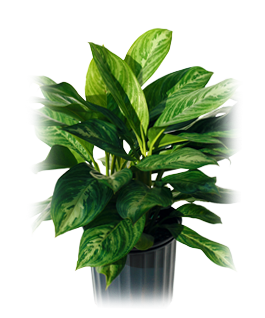Light
Aglaonema prefers indirect lighting situations. It will do very well in areas where it receives filtered light (partial shade). Indoors a south, north or east facing window would be ideal.
Placement
Dining Room, Bedroom
Water Habits
Aglaonema will grow best in a moist environment, so it is important not to allow the soil to dry between waterings. Lightly water until the soil becomes a dark color, but not to the point the soil is no longer able to absorb the water..
Temperature
Ideal Temperature for Aglaonema: 70-75° F (21-24°C) Min: 60°F (15°C)
Did You Know ?
Aglaonema comes from the flowering family of plants called Araceae, which also contains the Peace Lily (Spathiphyllum). The Aglaeonema originally comes from the swamp areas of the rainforrest in the region of Asia. This plant is commonly known as the Chinese Evergreen and has become a very popular ornamental house/office plant for its ability to tolerate different lighting situations, as well as some neglect.





























